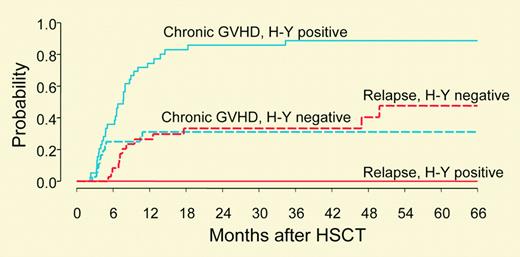Comment on Miklos et al, page ____
In a retrospective study of 121 hematopoietic stem cell transplantation patients, Miklos and colleagues apply a new ELISA assay for serum antibodies to H-Y antigens coded by the Y chromosome. They show that the presence of these antibodies is common in male recipients of female stem cells and that their presence correlates with both CGVHD and freedom from relapse.
T-cell–mediated cellular immune responses are known to cause acute graft-versus-host disease (AGVHD). As a result, preventative measures and treatments for AGVHD have focused on preventing or blunting T-cell responses. Chronic GVHD (CGVHD), while equally debilitating to transplantation patients, has been much more elusive. Neither animal models nor human biopsy material have clarified the immune mechanism that directly or indirectly causes CGVHD, and treatments have been both fairly nonspecific and only modestly successful. Any study that sheds real light on the immune response in CGVHD is therefore potentially very significant.
Miklos and colleagues chose to measure serum antibodies to 5 well-described minor histocompatibility antigens encoded by the human Y chromosome (H-Y). They developed a very sensitive enzyme-linked immunosorbent assay (ELISA) and first found that such antibodies were commonly expressed in 41% of healthy females (presumably including parous and transfused women) but only 7.8% of healthy males. Anti–H-Y antibody responses are not found early on after stem cell transplantation (SCT) and do not correlate with acute GVHD. However, between 4 and 12 months following transplantation they found that 52% of male recipients of female stem cells developed multiple, high-titer anti–H-Y antibodies, whereas only 8.7% of male recipients of male stem cells developed such antibodies. In addition, the posttransplantation emergence of such antibodies correlates strongly with the development of chronic GVHD. Even more stunning, the development of such antibodies correlates completely with protection against disease relapse (see figure). Although these measurements do not prove that these or any other antibody responses actually cause CGVHD or prevent relapse, they do prove that B-cell responses are part of these processes. Of note, Ratanatharathorn et al1 point out in a recent study that chimeric anti-CD20 (rituximab) may be an effective treatment for resistant CGVHD, supporting the possibility that B cells are directly pathogenic in CGVHD.FIG1
The cumulative incidence of chronic GVHD and relapse as a function of H-Y antibody response. See the complete figure in the article beginning on page 2973.
The cumulative incidence of chronic GVHD and relapse as a function of H-Y antibody response. See the complete figure in the article beginning on page 2973.
Miklos et al's study raises alternative, intriguing hypotheses. Perhaps women who generate anti–H-Y antibodies in the setting of pregnancy or transfusion develop B-cell memory that actually improves their ability to kill male tumor cells after transplantation (and cause CGVHD). On the other hand, maybe the development of anti–H-Y antibodies after SCT is not related to pretransplantation immunization but simply marks those donor-recipient pairs whose genetic disparities predispose to a strong anti–minor histocompatibility antigen (anti-mHA) immune response, irrespective of immunization history. Whether the next prospective studies will therefore develop new prognostic tests for CGVHD, new treatments for CGVHD, new immunization techniques to prevent relapse, or all of these, only the future will tell. To B (cell) or not to B, that will be the question. ▪


This feature is available to Subscribers Only
Sign In or Create an Account Close Modal